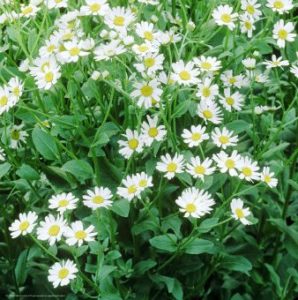August 2017 Herb of the Month: Costmary
 Costmary is an herb of many names. Its principal common name shows it to be an herb dedicated to the Virgin Mary. The alternate name, Sweet Mary, likely refers to the Virgin Mary, too, or it could refer to Mary Magdalene: the early herbalists Gerard and Culpeper mentioned an herb called maudlin (Magdalene) which was identical or very similar to costmary.
Costmary is an herb of many names. Its principal common name shows it to be an herb dedicated to the Virgin Mary. The alternate name, Sweet Mary, likely refers to the Virgin Mary, too, or it could refer to Mary Magdalene: the early herbalists Gerard and Culpeper mentioned an herb called maudlin (Magdalene) which was identical or very similar to costmary.
Other common names for costmary allude to its uses. As a flavoring of ales and spiced wine, it was called alecost. The name allspice applied to this herb may be a variant spelling for ale-spice, or perhaps the herb’s scent reminded someone of the spice allspice. Sweet tongue, a common name in Maine, refers to both the taste and the shape of the leaves. The large, oblong leaves of costmary make neat, fragrant bookmarks, a use that spawned the old names Bible Leaf or Bible Plant. The minty odor, which persists in the dried leaf, might repel silverfish or book lice from the family
Bible, and the leaf could be sniffed surreptitiously during long sermons to maintain wakefulness.
Stiff, leafy stalks of costmary rise from spreading rhizomes. The upward-pointing, silvery-haired, pale-green leaves with fine, rounded teeth may measure as large as 12 by 2 inches. Lower leaves are stalked and large, the upper ones stalkless and progressively smaller. The flowers, in clusters
of tiny yellow buttons at the top of 3-foot stalks, bloom in very late summer in northern climates, not at all if plants are grown in shade.
Like most other herbs, costmary was once used medicinally to treat a variety of ills, including dysentery, “quotidien ague,” “evil, weak and cold livers,” and “stoppings” of the brain. It has also been used to bring on delayed menstrual periods; if you are pregnant, avoid internal use. The herb is astringent and was commonly taken internally as a tea or mixed with sugar as a conserve. Externally, it could be mixed with other herbs
into ointments used to treat sores and itching. Today, we’re more likely to use the leaves to scent a relaxing bath or to dry them for use in sachets and potpourri.
The mint-flavored form of costmary can be used in cooking, though Frances A. Bardswell’s description (in The Herb Garden, 1930) of the flavor as “like weak Mint sauce” with “an after-taste of bitterness” isn’t much of an endorsement. Try using the fresh, young leaves in iced tea and in green or fruit salads and coleslaw. Add some shredded leaves to soups and cream sauces, too. Cover fish with a whole large leaf before baking it, or place one in the bottom of a cake tin before pouring in the batter.
Costmary can be used around the home as well. The Big Book of Herbs suggests using it with rosemary, cloves, bay, cinnamon, and sage for potpourri.
More common in gardens a few centuries ago, costmary makes a fine ornamental today, especially in combination with other large-leaved herbs such as comfrey, elecampane, and borage. Scented geraniums, sages, and colorful nasturtiums are other good companions.
— Presented by Janet Lindsteadt
